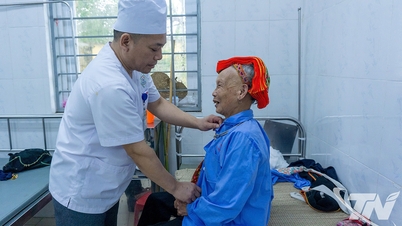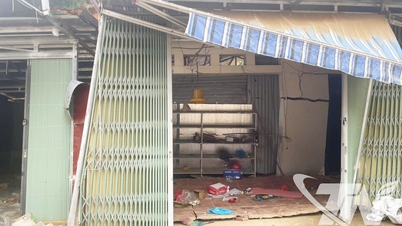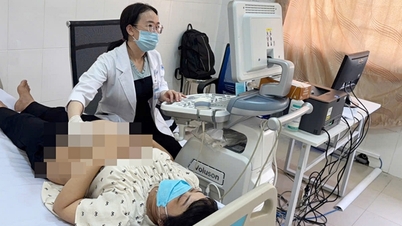To support people in areas affected by natural disasters and floods, Hanoi Eye Hospital 2 organized a community examination program "Keep the light - Spread love" at Dao Xa Primary School (Tan Khanh commune, Thai Nguyen) to provide free consultation and glasses for students here.

Free eye exams for children in the program.
By bringing along 80% of the equipment system, which is almost equivalent to a specialized clinic, the working group performed a comprehensive examination; detected deep pathologies such as corneal scars, nystagmus, strabismus, entropion, and combined consultation and outlined personalized treatment directions for each case.
The hospital's community-oriented activities aim to implement the policies of the Party, State and Ministry of Health on bringing high-quality, specialized healthcare to people at the grassroots level.
On November 10, after examining 374 students, doctors discovered that 108 students had refractive errors, accounting for 29.3%, of which 26 students were nearsighted over 2 degrees. Notably, 92 students had never worn glasses or had never had an eye exam.
In class 1A alone, out of 33 students, 19 have refractive errors (accounting for nearly 60%), mainly nearsightedness, farsightedness and astigmatism, while according to doctors, this is a very sensitive age for vision when children start learning to read and write.
During the examination, there was a case where the doctor prescribed glasses for the student, but the family hesitated because they were afraid of "wild eyes" and affecting aesthetics.
According to experts, this is a dangerous misconception. When taking off glasses, children have blurred vision, making their eyes look tired. This is a normal reaction, not "wild eyes". On the contrary, not wearing glasses with the right prescription can cause myopia to increase rapidly, because the eyeball axis must stretch to catch up with the image, each 1mm of lengthening can increase myopia by 2-3 degrees.
Many children have congenital eye defects that are not detected early, while doctors say that if not intervened early, children are at risk of permanent vision loss.
During the examination, NTD, a 5C student, was found to have 10 degrees of nearsightedness in his right eye, 2 degrees of astigmatism, 180 degrees of axial astigmatism, and alternating squint. This is a very high level of nearsightedness and astigmatism, causing the image to be blurred and distorted.
However, it is worth mentioning that D. still believes that he sees clearly, studies and watches TV normally. The doctor explained that D.'s case is because his left eye has 10/10 vision, so when both eyes are open, the brain automatically "ignores" the blurry image from the right eye, only using the clear image from the left eye. This phenomenon is called visual inhibition.
When the brain does not receive signals from the weak eye, the vision of that eye will gradually decrease, leading to latent amblyopia. Even if the child wears glasses with the correct prescription, it will be difficult to fully restore vision. Doctors advised D.'s family to take their child to a specialist for timely treatment.
Dr. Hoang Thanh Nga - Hanoi Eye Hospital 2 said that the rate of children with myopia and other refractive errors is increasing, not only in the city but also in the countryside. Many students are not detected early, leading to amblyopia or strabismus - complications that can have long-term effects on visual function.
Factors that increase refractive errors in children include intense studying, incorrect sitting posture, lack of light and overuse of electronic devices.
More worryingly, many children are not examined early, leading to complications of amblyopia or strabismus, complications that can have long-term effects on visual function. The golden period for treating amblyopia is before the age of 8, after which recovery will be very difficult.
Dr. Nga warns that watching too many electronic devices is one of the risks that cause children to have refractive errors. However, children do not only watch electronic devices but also get the disease. Therefore, many parents subjectively think that if their children do not watch phones, they will not be nearsighted, forgetting that there are many other factors.
Doctors also recommend that refractive errors should be screened regularly, and that children should not wait until they show signs of eye strain or pain before going for an examination. Ideally, parents should have their children's eyes examined at least once before the new school year.

After the examination, children will be fitted for free glasses.
In addition, families should encourage children to participate in outdoor activities, sit in the correct posture, have enough light, avoid bending down or studying in the dark; limit handheld electronic devices such as phones and tablets; if children show signs of squinting or blinking, take them to a medical facility for immediate examination.
It is known that Hanoi Eye Hospital 2 plans to periodically organize examinations, consultations and communication on visual health at schools and rural areas.
In addition to early detection and timely treatment of eye diseases, the program also coordinates with local authorities and schools to raise community awareness of school eye care and blindness prevention according to the national strategy on blindness prevention for the period 2020 and vision 2030, with the common goal of "increasing people's access to preventive services, early detection, treatment and eye rehabilitation, reducing the rate of preventable blindness, striving to eliminate the main causes of blindness for all people, especially millions of blind people, the right to sight as recommended by the World Health Organization".
Source: https://suckhoedoisong.vn/gan-30-tre-tai-mot-truong-tieu-hoc-mac-tat-khuc-xa-nhung-phan-lon-chua-tung-deo-kinh-169251111110138991.htm



![[Photo] Chu Noodles - the essence of rice and sunshine](https://vphoto.vietnam.vn/thumb/1200x675/vietnam/resource/IMAGE/2025/11/11/1762846220477_ndo_tl_7-jpg.webp)
![[Photo] Prime Minister Pham Minh Chinh chairs a meeting on housing policy and the real estate market.](https://vphoto.vietnam.vn/thumb/1200x675/vietnam/resource/IMAGE/2025/11/11/1762838719858_dsc-2107-jpg.webp)































































































![Dong Nai OCOP transformation: [Article 4] Reaching national standard products](https://vphoto.vietnam.vn/thumb/402x226/vietnam/resource/IMAGE/2025/11/11/1762825820379_4702-cac-san-pham-trai-cay-chung-nhan-ocop-nongnghiep-174649.jpeg)


![Dong Nai OCOP transition: [Article 3] Linking tourism with OCOP product consumption](https://vphoto.vietnam.vn/thumb/402x226/vietnam/resource/IMAGE/2025/11/10/1762739199309_1324-2740-7_n-162543_981.jpeg)






Comment (0)